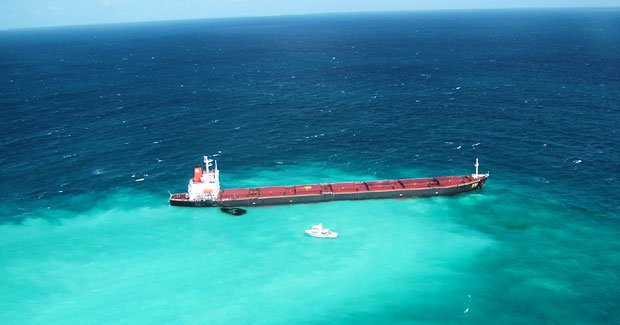Experts fear major reef damage from stranded ship

RESCUING THE CHINESE SHIP stranded in the Great Barrier Reef could cause major damage to the delicate ecosystem, and highlights the necessity for marine pilots, experts say.
The carrier ship, Shen Neng 1, ran aground about 70 km east of Great Keppel Island late Saturday afternoon, laden with 65,000 tonnes of coal and approximately 975 tonnes of heavy fuel oil. Queensland Premier Anna Bligh confirmed today that equipment will be sent to pump remaining oil off the craft and onto another ship.
David Booth, a marine ecologist at the University of Technology, Sydney, says oil has the potential to cause significant damage to the reefs near Great Keppel Island.
“The worst case scenario is that the hull breaks and the oil disperses. If it happens to be low tide, currents would take the oil straight onto the reef, which could be very damaging,” he says. “There’s a lot going on out there on the reef, such as fishing pressures and coral bleaching — this could be another nail in the coffin.”
Worst-case scenario
So far, Marine Safety Queensland have reported that there is “a thin oil sheen near the ship measuring 600 by 300 metres.” Dispersants have been deployed to counter the spill, but David warns these can be even more toxic than the oil.
Chairman of the Great Barrier Reef Marine Park Authority, Dr Russell Reichelt, says a full assessment is required to determine the damage to the environment, from both the impact of the 230 m vessel, and the small amount of oil that has leaked from it.
“We have observed damage to the Reef from the grounding incident itself, as evidenced by the plume of coral sediment that can be seen around the ship,” Russell says.
He warns the reef remains at risk until the salvaging process of the vessel is complete. “It is critical now that there is a successful salvage with no further damage to the ship and no loss of oil or its cargo of coal,” he says. Experts are currently examining the situation to determine the safest and most practical method of salvaging the ship.
The disaster has made public a debate about whether all large ships travelling through the Great Barrier Reef should have marine pilots to help them navigate the approved shipping channels. Such a navigator was absent from the Shen Neng 1 when it went off course on Saturday and found itself in the Douglas Shoals, 15 km from the shipping lane.
Down to human error
Robin Beaman, an expert on marine mapping at James Cook University in Townsville, Queensland, says he is puzzled at the degree to which the carrier went off-course.
“I’m very surprised where they ran aground. It’s not an isolated reef and it’s very well mapped. There are good nautical charts of the seabed in this region,” he says. “What were they doing there?”
There are detailed 3-D maps of the seabed for this part of the Great Barrier Reef, as well as nautical chart data, Robin says. “[But] it’s one thing to have thorough nautical charts, and another to have a human interacting with them… A problem like this is generally down to human error.”
David agrees that he is “dumbstruck that there aren’t pilots on these vessels when they do manoeuvres inshore.” He told Australian Geographic that he hopes the incident will promote the need for better reef protection from sea traffic, which is set to increase as development plans continue for a new port at Gladstone.
Authorities are planning to pump oil from the ship tomorrow or Thursday, and are yet to decide if coal should be removed before a full salvage operation gets underway.
LINKS
Risky rescue planned for leaking ship in Great Barrier Reef

